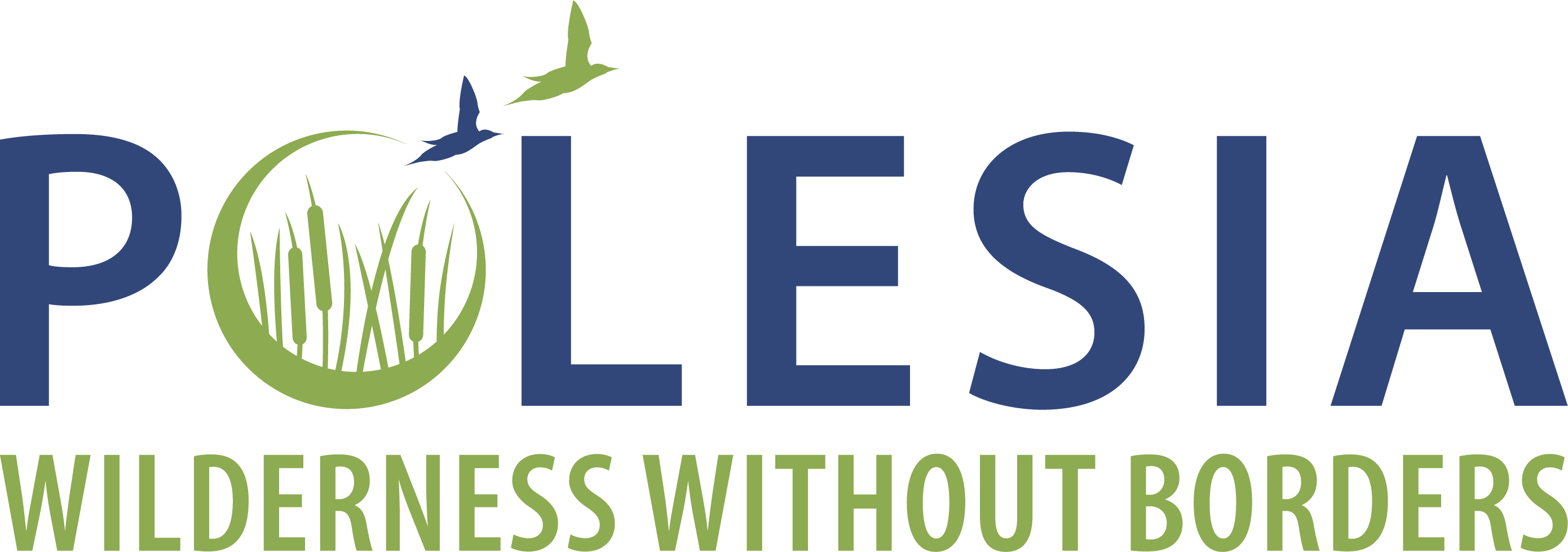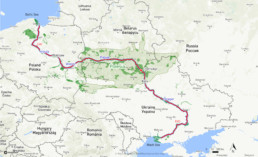Threats to Polesia's natural landscape
Polesia’s vast natural landscapes are at risk. Climate change, fragmentation, wetland drainage, intensive forestry, infrastructure development, illegal mining, and unsustainable resource extraction threaten the integrity of this invaluable ecosystem.
E40 waterway
A potential major man-made canal route between the Baltic Sea and the Black Sea is threatening to transform the Pripyat River, one of Europe’s last major natural rivers. The plan for the ‘E40 waterway’ was initiated by representatives from Belarus, Poland, and Ukraine. A committee was established in 2013 to drive forward plans to build the E40 waterway. The realisation of this waterway would have a catastrophic impact on the nature and wildlife of Polesia. The E40 would bisect protected areas along its entire length, destroying vital links between key habitats. By straightening the Pripyat, numerous meanders and large areas of intact floodplains could dry up, and important habitats within the protected areas would be lost.Find out more about E40.
Wetland drainage
Polesia is a lowland area rich in a variety of wetland ecosystems: bogs, peatlands, river floodplains with floodplain meadows and wetland forests. Unfortunately, hundreds of thousands of hectares of wetlands in Polesia were drained in the 20th century, mainly for agricultural purposes. Today, we can see the results of this process: the degradation and loss of habitats, a decrease in biodiversity, reduction in fresh water supplies, soil degradation, the increasing frequency of droughts and devastating wildfires, and reduced resilience to climate change. All of this threatens not only the unique wilderness of Polesia, but also the economy and well-being of its people.
Climate change
Healthy, fully functioning wetlands play a key role in climate change mitigation. They buffer extreme natural events, such as droughts and floods, regulate the humidity and temperature of the air and land surface, and absorb and sequester carbon. At the same time, disturbed wetland ecosystems are highly vulnerable to climate change. As it gets warmer, they lose more and more water, dry up and start to release the carbon that was previously sequestered deep down, exacerbating the greenhouse gas problem. The drying up of wetlands leads to the degradation and loss of valuable ecosystems that make Polesia so precious and unique. This is why we are focusing on restoring wetlands.
Fires
Small natural fires that start spontaneously and burn themselves out are normal in many natural systems. However, the excessive drainage of Polesia's wetlands has led to an increase in the frequency of large, devastating fires. They damage valuable ecosystems, destroy peat and vegetation. These fires also threaten the safety, health and lives of people. Peatland fires are particularly dangerous. They are not always easy to detect and very difficult to extinguish. A significant proportion of Polesia's drained peatlands are located in the Chornobyl Exclusion Zone, a highly contaminated area. Not once have large fires occurred in this area, causing severe air pollution far beyond their epicenters. Burning peat releases carbon, sulphur and nitrogen compounds, as well as soot and radioactive particles, causing serious damage to human health. In 2020, firefighters stopped the flames near a radioactive waste storage. In the same year, peatland fires brought Kyiv to the top of the world's cities with the heaviest air pollution. Researchers predict that the problem is likely to worsen as the climate changes, and say that maintaining and restoring natural hydrological regimes is the most effective nature-based solution.
Development of transport infrastructure
Polesia is not only untouched wilderness, but also cities and numerous rural settlements, farmlands, farms, industrial enterprises and, of course, a road network connecting all these objects. However, building new roads through wilderness areas is not harmless. It increases the anthropogenic stress on ecosystems and threatens populations of species that are particularly sensitive to human disturbance, such as the Greater Spotted Eagle. Increasing road density causes fragmentation, increased number of wildfires and reduced habitat quality for some territorial animals, such as lynx or wolves. When built in wetlands, such roads disrupt their hydrological regimes. Intact and sustainable ecosystems are also threatened by the introduction of invasive plants, whose seeds and parts can be carried along with sand and other construction materials.
Peat extraction
Industrial peat extraction by state-run and private companies is still widespread in Polesia. Peat is used domestically as an energy source and exported as a substrate for agricultural purposes. Peat extraction is one of the main causes of wetland degradation in the region. It is the reason why in the Zhytomyr region (Ukrainian Polesia) the area of peatlands as such has decreased by 50% in the last 70 years. Peat extraction is accompanied by habitat destruction and intensive drainage, turning peatlands from carbon stores into sources of intense greenhouse gas emissions. Though being obliged to take measures for further recultivaton of the disturbed peatlands, companies often ignore this regulation. Ecosystems recover very slowly or not at all after peat extraction is over. At the same time, a rough estimate of carbon dioxide emissions associated with peatland drainage, peat extraction and use in Ukraine is at least 5 million tonnes per year.
Unregulated berry picking
With its diverse mosaic of mires, bogs, forests and marshes, Polesia is the perfect habitat for many different berry species, such as cranberries and bilberries. From late summer until the first frosts, the forest floor is covered with fruiting bilberry bushes while the mires are covered with cranberries. The large amount of berries available provides an important economic resource for the local community, and local people collect and sell them throughout the summer and autumn. However, this negatively affects the local flora and fauna due to the increased intensification of berry picking activities. One area of particular concern is the Almany Mires Nature Reserve. Almany is a 100,000 hectare natural transitional mire of outstanding European and global conservation importance. Located in Belarus, adjacent to the Ukrainian border, this mire is heavily affected by overharvesting when berry pickers flock to this pristine habitat in the summer months. In an attempt to increase their berry harvests, the pickers use prohibited mechanical devices that severely damage the berry bush and reduce its yield for the upcoming years. They build illegal roads, leave large quantities of litter, set up temporary camps inside the forest, and trample vegetation. Their carelessness is often the cause of forest fires. Such activities disturb sensitive breeding animals, such as the Greater Spotted Eagle.
Amber mining
Illegal amber mining has increased in the Ukrainian part of Polesia in recent years. Amber is extracted by cutting down large areas of trees, digging holes and pumping water underground. The amber then floats to the surface and can be collected, leaving behind a devastated, barren landscape with holes, the fertile layer destroyed and no shrubs or grass. As a result of the massive pumping of water, the water regime of the areas is severely disturbed: some places are drained, while others are flooded. Experts estimate that more than10,000 hectares in the Rivne region alone need to be recultivated after the destructive amber mining. Its traces can be found even in primary forests of high conservation value and in the areas of nature reserves or national parks, where such practices cause particular damage. This type of mining is illegal, but attempts by the Ukrainian government and military to stop this practice have often failed. Mining is highly lucrative and miners are often heavily armed, making it extremely dangerous to tackle the industry.



The project “Polesia – Wilderness Without Borders” is part of the Endangered Landscapes & Seascapes Programme and is funded by Arcadia. The project is coordinated by Frankfurt Zoological Society (FZS).
This post is also available in UKR.


